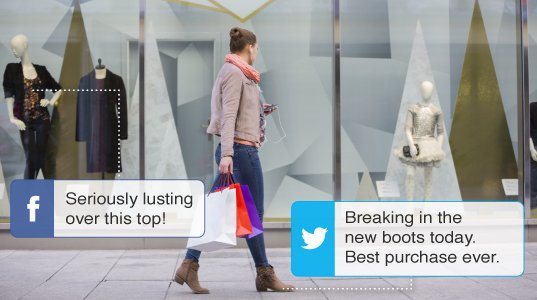Download our ebook The Retail Marketer’s Guide to Content-Driven Commerce to discover the types of content every commerce company needs and why content enhances customer trust.
—
These days, both ecommerce brands and brick-and-mortar retailers absolutely need to have an impressive social media presence, but it’s not always for the reason you might think. For the most part, your average customer isn’t turning to Pinterest, Facebook, Instagram or Twitter to buy stuff on the spot. Major retailers such as Gap, Nordstrom and J.C. Penney abandoned efforts several years ago to make direct sales on Facebook sites because the fact is: it wasn’t working, according to a report from eMarketer covering social commerce.
Indeed, the data isn’t very encouraging when it comes to the value of social for driving direct sales according to the eMarketer data. Email and search are far more critical. In fact, conversions from social drove less than 1% of revenue.
So, why spend all that time and effort cultivating your brand’s social media presence?
Where social media really shines is in its ability to influence future buying behavior as consumers seek more information about products and act on recommendations made by people in their network, according to the eMarketer data.
“The psychology is that people don’t want to do things alone,” Sam Decker, CEO and co-founder of Mass Relevance (now Spredfast), told eMarketer. “They want to know they have made a smart decision and others are making that decision as well.”
Social media certainly can contribute to that sense of well-being. 30% of shoppers surveyed said social media from retailers influenced where they shopped. Social media from brands also moved 30% of the shoppers to action. And for first-time purchases, social media influenced 23% of buying decisions, per eMarketer data. Notably, consumers also turn to a brand’s social media pages to get more information about products. A surprising 61% said they turned to YouTube sites for such intelligence; while 56% turned to Facebook and the same percentage looked to Pinterest. Out of 5 major social networks, Twitter took the lead when it came to where shoppers kept up with a brand’s activities, with 57% using it for that purpose. But for making purchases, Twitter didn’t fare so well: only 15% made a purchase via the social network.
Demographics matter, too, according to other studies cited by eMarketer. Women were more than 1.5x more likely to make purchases based on social media posts as men were. That same study showed millennials were almost twice as likely to buy something their friends, family and other influentials favored as compared with their Gen X counterparts. Curiously, the income level of respondents didn’t have much of an impact on the propensity to follow social recommendations.
Does it matter which social media channels you use to reach customers?
A 2014 study published in the Journal of Business and Academic Research looked at how 249 shoppers were influenced by different social media outlets, what they purchased and how much they spent. The respondents were asked which social media network they were using when they saw the recommendation that led to their purchase.
Facebook led the pack, with 59% acting upon a recommendation on the site, while 37% said they were using Twitter. But for people under age 22, Twitter played a much more important role, accounting for 52% of the product recommendations.
“This result paints an interesting picture of perhaps a shifting trend in social media, in which younger consumers seem to be seeking a more instantaneous model of social media than can be provided by Facebook,” wrote the authors, Lukas P. Forbes, associate professor of marketing of Western Kentucky University and Eve M. Vespoli.
The fact that younger people favor media facilitating fast and instantaneous information isn’t exactly startling. Consider the popularity of newer apps like Snapchat, where messages disappear after being read. Much more intriguing: their finding about how social media tended to influence purchases at opposite ends of the price spectrum. 41% percent of the items that shoppers purchased through recommendations on social media cost less than $20 and another 38% cost more than $200. It seems that when it comes to inexpensive impulse purchases, consumers are willing to take a chance based on a friend’s word. Likewise, the sort of bigger ticket items that shoppers tend to research heavily also benefited from a strong recommendation. Interestingly, 42% of the consumers interviewed in this study followed the recommendation of someone they didn’t know very well and wasn’t considered an expert or influencer. “Getting a recommendation from “anyone” was considered credible whether or not the person actually had credibility,” according to the researchers.
The takeaway from all this data?
Clearly social media helps shape opinions and can lead to purchases, even if it’s not stimulating immediate click-throughs and purchases. For marketers, that means paying close attention to which social media sites are working best for your brand and putting your energy where it matters most.
Learn more about Sailthru by Marigold by Sailthru’s Mobile Marketing Automation Platform and how you can leverage social media to influence purchase decisions.
